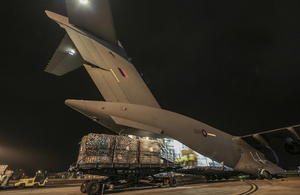RAF carries UK aid to cyclone-hit Vanuatu
Royal Air Force C-17 transport plane has left the UK carrying vital aid to Vanuatu in response to devastation caused by Cyclone Pam.

C-17
Following a request for Defence assistance from the Department for International Development (DfID), a Royal Air Force C-17 transport plane has left the UK carrying vital aid to Vanuatu in response to devastation caused by Cyclone Pam.
The aircraft departed from RAF Brize Norton early on Monday 16 March and will travel to the Royal Australian Air Force base at Amberley in Australia, where it will join the international relief effort. The plane is carrying 1,640 shelter kits for use by families of five people and more than 1900 solar lanterns with inbuilt mobile phone chargers. These supplies will help to provide protection to some of the most vulnerable people affected by the cyclone.
The aircraft is expected to arrive in Australia early in the morning of Wednesday 18 March, local time, and from there will undertake numerous support flights to and from Vanuatu, to deliver supplies and personnel in aid of the relief effort.
Defence Secretary Michael Fallon, said:
At this time of terrible devastation, our hearts go out to the people of Vanuatu. Whenever and wherever such natural disasters strike, the UK helps out in whatever way we can. The Royal Air Force C-17 aircraft we have sent carries much-needed aid equipment and is fully prepared for a wide range of short-notice tasks. Our RAF personnel will turn their hands to any tasks which the clear-up requires.
RAF carries UK aid to cyclone-hit Vanuatu
The C-17 is a versatile aircraft, capable of rapid delivery of all types of cargo for peacekeeping and humanitarian missions anywhere in the world. The RAF C-17 fleet previously provided humanitarian assistance during the aftermath of the Indian Ocean Tsunami, as well as the Pakistan and Chilean earthquakes and the Philippines disaster zone, due to its ability to take off and land in inhospitable terrain and adverse weather conditions.